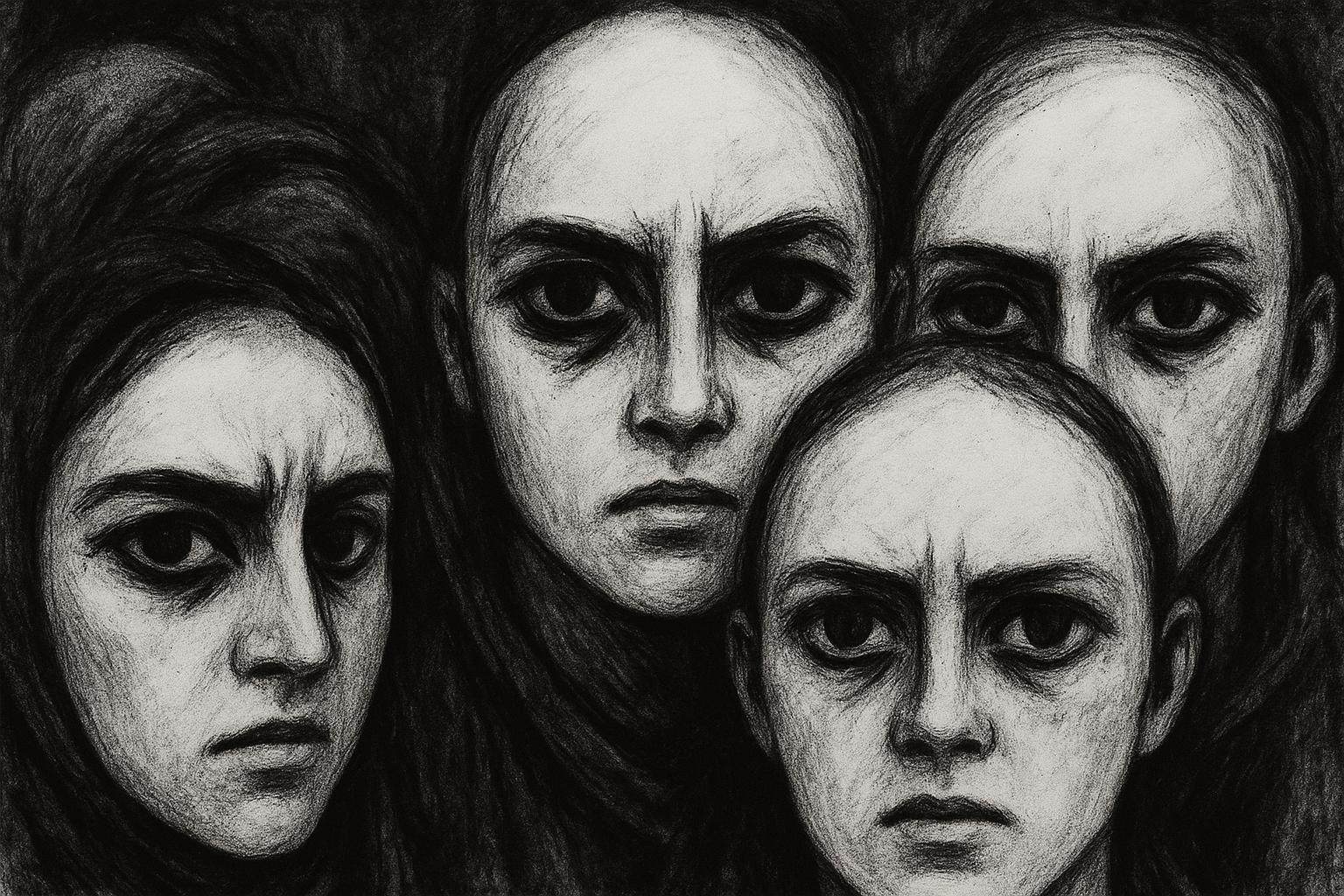There are no tanks or tear gas in Metamorphika Studio in Hackney, London, only heavy, charcoal-drawn eyes staring out from pale, formless faces. This quiet, urgent gaze forms part of Gazans’ View of the World, a striking monochrome piece by Palestinian artist Nabil Abughanima. It is among over 50 works displayed in Dlúthpháirtíocht — the Irish word for “solidarity” — an exhibition weaving together the histories and experiences of Palestine and Ireland. Born from a poem by co-curator Seán Óg Ó Muirí, the exhibition positions itself as one of the largest international showcases of contemporary Irish artists, while also providing an essential platform for Palestinian artists working in exile.
The exhibition is not static; it captures urgent realities. Many Palestinian artists showing work recently fled Gaza. Abughanima himself left the territory two months ago and now lives in France. Before the most recent war, he had begun building Gaza’s first independent animation studio. But the conflict shattered that dream. His art grapples with the siege of Palestinian myth and ancestral stories, reflecting on the loss of cultural values that underpin society as a whole.
Visitors to the gallery are met immediately by the work of the acclaimed Irish photographer Seamus Murphy, whose three decades documenting war and migration include a haunting mid-2000s visit to Gaza and the West Bank. His grainy images capture moments like men waiting anxiously at checkpoints, praying for passage to Israel where some might find work while many were rejected. Murphy remarks on the stark contrasts faced crossing from Gaza into Israel: “unbelievable social chaos and poverty” on one side, and “manicured roads and advanced technology” on the other, illustrating the severe inequalities under occupation.
The exhibition’s emotional terrain shifts upstairs, where surrealism replaces straightforward reportage. Palestinian artist Amal Al Nakhala, forced to relocate to Cairo, presents Flying People, a dreamlike painting of upside-down figures floating above jagged teeth, symbolising the distorted, brutal normalisation of occupation and death. “It shows how occupation becomes the norm,” she explains, “and death becomes normalised.”
One of the most visceral pieces is a collaboration between Irish artist Spicebag and Scottish artist Council Baby: a car door riddled with bullet holes, emblazoned with the Arabic words “I’m afraid of the dark.” It commemorates five-year-old Hind Rajab, who died in January 2024 after being trapped in a car under Israeli fire in Gaza. Her terrified voices pleading for help were recorded during an ordeal in which her family and paramedics perished beside her. Spicebag notes how Hind’s story resonates deeply amidst countless faceless victims, creating a direct, haunting human connection.
For many Irish artists involved, the exhibition’s solidarity is more than symbolic. They see parallels between historical Irish struggles and the present realities in Palestine. As Spicebag puts it, witnessing “armoured vehicles on residential streets — not there to protect you but to suppress you” evokes a deep, collective memory embedded in Ireland’s psyche.
Dlúthpháirtíocht is more than a platform for artistic expression; it is a form of resistance and direct support. All proceeds are donated to Dignity for Palestinians, a charity founded by Dr Musallam Abukhalil that provides food, water, and essential supplies to displaced families in Gaza. Abukhalil underscores the immediate impact of these contributions: “The money might go to a food basket, clean water, maybe something small for a camp. Art is resistance in Gaza, it always has been.” The charity’s work brings moments of joy amid hardship, such as video clips of children sharing a simple food parcel, their eyes alight with happiness despite the surrounding devastation.
Following its debut in London, the exhibition is touring Ireland, with planned stops in Dublin, Cork, and Belfast. Each venue hosts not only the artworks but also live performances, screenings, and workshops, amplifying cultural dialogue and fundraising efforts for Gaza. The exhibition features a diverse set of voices, including Irish artists like Jim Fitzpatrick and Aoife Cawley, and Palestinian artists such as Rula Halawani, further strengthening the cultural and political bonds across these distant yet connected struggles.
This exhibition is part of a broader wave of artistic solidarity across Ireland. Groups like Irish Artists for Palestine organise events and initiatives to highlight the humanitarian crisis while fostering enduring cultural ties. Parallel shows such as HeART of Gaza offer platforms for young Palestinian artists to share their experiences and resilience directly with Irish audiences, encouraging reciprocal artistic exchange.
Dlúthpháirtíocht effectively blends art with activism, illustrating how creative expression can forge connections, raise urgent awareness, and deliver tangible aid amid conflict. It confronts viewers with the human realities behind headlines and statistics — eyes that do not accuse or plead, but simply demand to be seen and remembered.
📌 Reference Map:
- Paragraph 1 – [1], [6], [7]
- Paragraph 2 – [1], [2], [6]
- Paragraph 3 – [1]
- Paragraph 4 – [1]
- Paragraph 5 – [1]
- Paragraph 6 – [1]
- Paragraph 7 – [1], [2], [3], [6], [7]
- Paragraph 8 – [1], [4]
- Paragraph 9 – [1], [3], [4], [5], [6]
Source: Noah Wire Services
